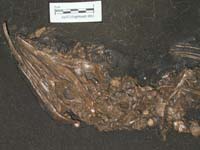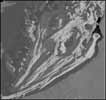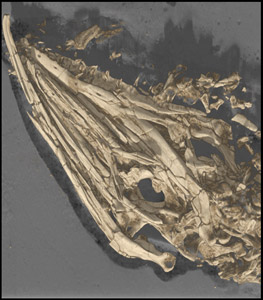Literature
ALIFANOV, V. R. 2000. The fossil record of Cretaceous lizards from Mongolia, p. 368-389. In M. J. Benton, M. A. Shishkin, D. M. Unwin, and E. N. Kurochkin (eds.), The Age of Dinosaurs in Russia and Mongolia. Cambridge University Press, Cambridge.
BAUR, G. 1890. On the characters and systematic position of the large sea-lizards, Mosasauridae. Science, 16:262.
BELLAIRS, A. 1949. Observations on the snout of Varanus, and a comparison with that of other lizards and snakes. Journal of Anatomy, 83:116-146.
BORSUK-BIALYNICKA, M. 1984. Anguimorphans and related lizards from the Late Cretaceous of the Gobi Desert, Mongolia. Palaeontologia Polonica, 46:5-105.
BULLET, P. 1941. Beiträge zur Kenntnis des Gebisses von Varanus salvator Laur. Viertejahresschrift der Naturforschenden Gesellschaft in Zurich, 87:139-192.
CALDWELL, M. W. 1999. Squamate phylogeny and the relationships of snakes and mosasauroids. Zoological Journal of the Linnean Society, 125:115-147.
CALDWELL, M. W. 2000. On the aquatic squamate Dolichosaurus longicollis Owen, 1850 (Cenomanian, Upper Cretaceous), and the evolution of elongate necks in squamates. Journal of Vertebrate Paleontology, 20(4):720-735.
CAMP, C. L. 1923. Classification of the lizards. Bulletin of the American Museum of Natural History, 48:289-481.
CONRAD, J. L. 2004a. Re-analysis of anguimorph (Squamata: Reptilia) phylogeny with comments on some problematic taxa. Journal of Vertebrate Paleontology, 24 (suppl. 3):47A.
CONRAD, J. L. 2004b. Skull, mandible, and hyoid of Shinisaurus crocodilurus Ahl (Squamata, Anguimorpha). Zoological Journal of the Linnean Society, 141:399-434.
ESTES, R. 1983. Sauria terrestria, Amphisbaenia. Gustav Fischer Verlag, New York, 10, 249 p.
EVANS, S. E., AND L. J. BARBADILLO. 1998. An unusual lizard (Reptilia: Squamata) from the Early Cretaceous of Las Hoyas, Spain. Zoological Journal of the Linnean Society, 124:235-265.
FÜRBRINGER, M. 1900. Zur vergleichenden Anatomie Brustschulterapparates und der Schultermuskeln. Janaische Zeitschrift für Naturwissenschaft, 34:215-718.
GAO, K.-Q., AND M. A. NORELL. 1998. Taxonomic revision of Carusia (Reptilia: Squamata) from the Late Cretaceous of the Gobi Desert and phylogenetic relationships of anguimorphan lizards. American Museum Novitates, 3230:1-51.
HAUBOLD, H. 1977. Zur Kenntnis der Sauria (Lacertilia) aus dem Eozän des Geiseltales, p. 107-122. In H. H. Matthes and B. Thaler (eds.), Eozäne Wirbeltiere des Geiseltales.Volume 2. Wissenschaftliche Beiträge, Wittenberg.
LEE, M. S. Y. 1998. Convergent evolution and character correlation in burrowing reptiles: towards a resolution of squamate relationships. Biological Journal of the Linnean Society, 65:369-453.
LEE, M. S. Y. 2000. Soft anatomy, diffuse homoplasy, and the relationships of lizards and snakes. Zoologica Scripta, 29(2):101-130.
LEE, M. S. Y., AND M. W. CALDWELL. 2000. Adriosaurus and the affinities of mosasaurs, dolichosaurs, and snakes. Journal of Paleontology, 74(5):915-937.
NORELL, M., AND K.-Q. GAO. 1997. Braincase and phylogenetic relationships of Estesia mongoliensis from the Late Cretaceous of the Gobi Desert and the recognition of a new clade of lizards. American Museum Novitates, 3211:1-25.
PREGILL, G. K., J. A. GAUTHIER, AND H. W. GREENE. 1986. The evolution of helodermatid squamates, with description of a new taxon and an overview of Varanoidea. Transactions of the San Diego Society of Natural History, 21:167-202.
SWOFFORD, D. L. 2001. PAUP. Smithsonian Institution, Washington, DC.
WU, X.-C., D. B. BRINKMAN, AND A. P. RUSSELL. 1996. Sineoamphisbaena hexa tabularis, an amphisbaenian (Diapsida: Squamata) from the Upper Cretaceous redbeds at Bayan Mandahu (Inner Mongolia, People's Republic of China), and comments on the phylogenetic relationships of the Amphisbaenia. Canadian Journal of Earth Sciences, 33(4):541-577.
ZAHER, H., AND O. RIEPPEL. 1999. Tooth implantation and replacement in squamates, with special reference to mosasaur lizards and snakes. American Museum Novitates, 327:1-19.




 ,
, 










